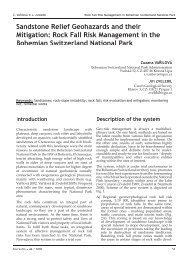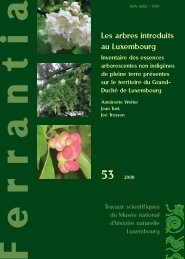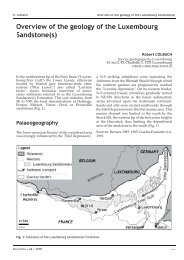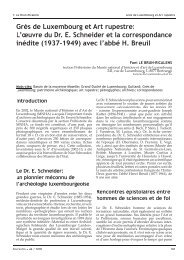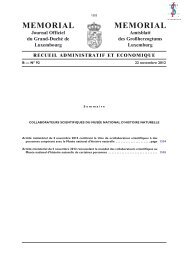Weathering morphologies of the Fontainebleau Sandstone and ...
Weathering morphologies of the Fontainebleau Sandstone and ...
Weathering morphologies of the Fontainebleau Sandstone and ...
You also want an ePaper? Increase the reach of your titles
YUMPU automatically turns print PDFs into web optimized ePapers that Google loves.
M. Thiry <strong>Wea<strong>the</strong>ring</strong> <strong>morphologies</strong> <strong>of</strong> <strong>the</strong> <strong>Fontainebleau</strong> <strong>S<strong>and</strong>stone</strong> <strong>and</strong> related silica mobilityDissolution bowls with silica flangeCircular decimetric-sized bowls oen form on <strong>the</strong>bare s<strong>and</strong>stones flats <strong>of</strong> <strong>the</strong> ridges, as well as on <strong>the</strong>domes (Fig. 2H). These bowls are water filled <strong>and</strong>frequently overflow during autumn <strong>and</strong> wintertime. During spring <strong>and</strong> summer, <strong>the</strong>ir water levelvaries <strong>and</strong> <strong>the</strong>y oen oen oen oen dry up completly. The boom boom boom boomis generally covered by an organic-rich s<strong>and</strong>, <strong>and</strong>water pH is about 5.The mouth <strong>of</strong> <strong>the</strong>se bowls is systematicallyunderlined by an indurated roll. A silica crustalso oen oen lines <strong>the</strong> inside <strong>of</strong> <strong>the</strong> bowls, above <strong>the</strong>mean water level. The boom boom boom <strong>of</strong> <strong>the</strong> bowls, nearlyflat, is devoid <strong>of</strong> silica crust <strong>and</strong> on <strong>the</strong> contraryshows grooves about 1 cm-deep <strong>and</strong> which formpolygonal networks. In this way <strong>the</strong>se smallwea<strong>the</strong>ring features are highly interesting : <strong>the</strong>yshow in <strong>the</strong> same structure silica leaching <strong>and</strong>deposition. Some tilted blocks show several gener-ations <strong>of</strong> dissolution bowls : <strong>the</strong> younger onesbeing in "living" position, whereas <strong>the</strong> older ones,that have undergone <strong>the</strong> tipping, do not longerkeep water.<strong>the</strong> chelates formed in <strong>the</strong> top soils <strong>and</strong> also fromleaching <strong>of</strong> biogenic silica related to <strong>the</strong> vegetationcover. Silica deposition in form <strong>of</strong> opal occurs above<strong>the</strong> ground level, in <strong>the</strong> outcropping s<strong>and</strong>stones .These opal-enriched crusts form at <strong>the</strong> top <strong>of</strong> <strong>the</strong>s<strong>and</strong>stone domes <strong>and</strong> around <strong>the</strong> temporary waterbowls. These deposits most probably originatefrom <strong>the</strong> pore water <strong>of</strong> <strong>the</strong> s<strong>and</strong>stone, pore waterrising up to surface by capillarity <strong>and</strong> concentratingunder severe evaporating conditions that occur on<strong>the</strong> bare stone. The climate in <strong>Fontainebleau</strong> (meanannual temperatures <strong>of</strong> 10.2°C <strong>and</strong> 722 mm rainfallin 180 days)a priori seems not very favourable,s<strong>and</strong>stone ridge1 mSilica mobilty <strong>and</strong> wea<strong>the</strong>ringrateIn <strong>the</strong> <strong>Fontainebleau</strong> Forest, <strong>the</strong> s<strong>and</strong>stonesdo not display any mechanical, nor aeolian orglacial erosion feature. The <strong>morphologies</strong> <strong>of</strong> <strong>the</strong>s<strong>and</strong>stones mainly result from silica dissolution<strong>and</strong> to a lesser extent from silica deposition.The silica dissolution first wears away <strong>the</strong> edges<strong>of</strong> <strong>the</strong> angular fractured blocks, which becomerounded, <strong>and</strong> lastly leads to <strong>the</strong> development <strong>of</strong>very regular dome-shaped boulders. Fur<strong>the</strong>r disso-lution arise with <strong>the</strong> hollowing <strong>of</strong> alveoles <strong>and</strong>bowls. These dissolutions occur on outcroppingblocks, above <strong>the</strong> ground level. O<strong>the</strong>r major lution features are related to <strong>the</strong> formation <strong>of</strong>overhangs which bring up mushroom-like rockstopped by larger domes (Fig. 2G), or even linearconcave features on massive s<strong>and</strong>stone pans. Theselaer laer laer laer features, which oen oen oen oen show typical polygonalgrooves, may form at depth, on buried or partlyburied s<strong>and</strong>stones, in contact with <strong>the</strong> soil. Organiccompounds in soils <strong>and</strong>pound deposits mayfavour silica dissolution <strong>and</strong> chelation (Benne (Bennedisso-1991).In parallel, quartz crystallization occurs at depth,in <strong>the</strong> fractures, oen oen oen oen toge<strong>the</strong>r with iron oxydesdeposition, beneath <strong>the</strong> discontinuous s<strong>and</strong> cover<strong>and</strong> <strong>the</strong> podzolic soils <strong>of</strong> <strong>the</strong> ridges. Due to <strong>the</strong>lack <strong>of</strong> feldspars <strong>and</strong> clay minerals in <strong>the</strong> upperleached <strong>Fontainebleau</strong> S<strong>and</strong>, <strong>the</strong> deposited silicamay mainly originate at depth from destruction <strong>of</strong>s<strong>and</strong>stone boulderdissolution bowlorganic-rich soil<strong>Fontainebleau</strong> <strong>S<strong>and</strong>stone</strong><strong>Fontainebleau</strong> S<strong>and</strong>waterlevel0,5 mprimary shape <strong>of</strong> <strong>the</strong>s<strong>and</strong>stone block0,2 msilica depositionsilica dissolutionsilica migrationFig. 3: Sketches <strong>of</strong> silica mobility during wea<strong>the</strong>ring <strong>of</strong><strong>the</strong> <strong>Fontainebleau</strong> <strong>S<strong>and</strong>stone</strong>. Silica dissolution occurson <strong>the</strong> bare s<strong>and</strong>stone, but is enhanced in contact withsoils <strong>and</strong> in <strong>the</strong> pounds, due to complexation with organiccompounds.50 Ferrantia • 44 / 2005




